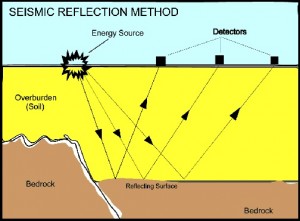by Bruce Wells | Dec 11, 2023 | This Week in Petroleum History
December 11, 1950 – Federal Offshore grows beyond Cannon Shot –
After decades of controversy and a 1947 U.S. Supreme Court decision, the federal government’s “paramount rights” offshore were established beyond a three nautical mile limit, an 18th century precedent based on the theoretical maximum range of a smooth-bore cannon. The nation’s highest court prohibited any further offshore development without federal approval. In 1954, the Bureau of Land Management held the first Outer Continental Shelf lease sale, earning the government almost $130 million.
Learn more in Offshore Petroleum History.
December 11, 1972 – First Geologist walks on Moon
Astronaut and geologist Harrison “Jack” Schmitt stepped on the moon, joining Apollo 17 mission commander Eugene Cernan. Lunar experiments included a surface gravimeter to measure buried geological structures near the landing site. Schmitt also returned with the largest lunar sample ever collected.

Geologist Harrison “Jack” Schmitt examined a boulder at the Apollo 17 Taurus-Littrow Valley lunar landing site in December 1972. Photo courtesy NASA.
Schmitt, who in 1964 received a PhD in geology from Harvard, was the first and last scientist on the moon, according to Cernan. When they left the Taurus-Littrow Valley landing site on December 14, 1972, he and the lunar geologist were the last of 12 men to walk on the moon. The 19th century petroleum product kerosene fueled all of the launches.
December 13, 1905 – Hybrids evolve with Gas Shortage Fears
“The available supply of gasoline, as is well known, is quite limited, and it behooves the farseeing men of the motor car industry to look for likely substitutes,” proclaimed the monthly journal Horseless Age.

An early hybrid, this 1902 Porsche used a gas engine to generate electricity to power motors mounted on the front wheel hubs.
The magazine, first published in 1895, described early motor technologies, including the use of compressed air propulsion systems, electric cars, steam, and diesel power — as well as hybrids.
About the time of the first American auto showin late 1900, engineer Ferdinand Porsche introduced his gas-electric “Mixte” in Europe. The hybrid used a four-cylinder gasoline engine to generate electricity. The engine powered two three-horsepower electric motors mounted on the front wheel hubs. The car could achieve a top speed of 50 mph.
December 13, 1931 – Oilfield discovered in Conroe, Texas
Independent producer George Strake Sr. completed the South Texas Development Company No. 1 well eight miles southeast of Conroe, Texas, where he had leased 8,500 acres. By the end of 1932 the oilfield was producing more than 65,000 of barrels of oil a day. But disaster struck in the Conroe field in 1933 when derricks and equipment collapsed into a burning crater of oil. The fire would be put out thanks to relief wells drilled by George Failing and his newly patented truck-mounted drilling method.
Learn more in Technology and the Conroe Crater.

December 13, 1985 – Route 66 decertified
Route 66, the “Mother Road” of modern highways since 1926, was decertified by the American Association of State Highway and Transportation Officials (AASHTO), which also voted to remove all Route 66 signs. Once stretching more than 2,400 miles from Illinois to California, the historic route was trailblazed in 1857 by a War Department expedition that included camels as pack animals.
By World War II, automobiles and trucks on the iconic roadway “helped to facilitate the single greatest wartime mobilization of labor in the history of the nation,” according to the National Park Service (NPS). By 1985, Route 66’s narrow asphalt paving and antiquated structure had been bypassed by the interstate system.
Learn more U.S. transportation history in America on the Move.
December 14, 1981 – Dowsing No Help in Minnesota Oil Search
Seeking oil investors, a Minnesota promoter proclaimed that dowsing with copper wires had located petroleum deposits in Nobles County, according to the Minneapolis Tribune, which reported the promoter had hired, “a Texas oilman and evangelist to lead a prayerful search for oil.” Despite no geological evidence, local investors paid $175,000 to drill a well that found no indication of oil or natural gas after reaching a depth of 1,500 feet.
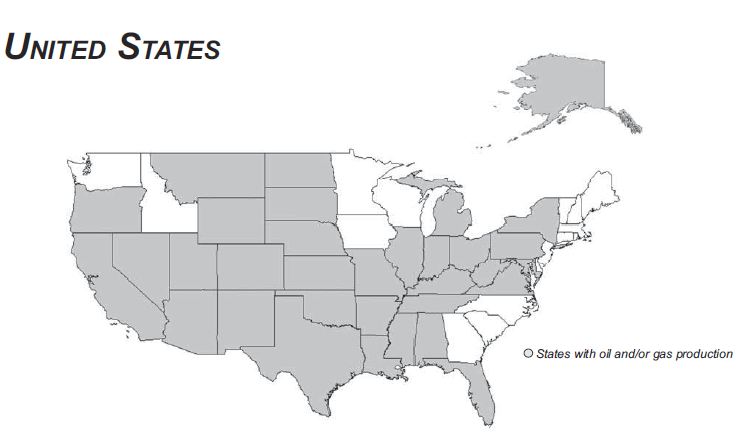
Minnesota is one of 17 states without any oil or natural gas production, according to the Independent Petroleum Association of America.
The Minnesota Geological Survey had reported in 1980 that of the state’s 17 exploratory wells drilled, “in suitable geologic settings,” none discovered commercial quantities of oil. The survey concluded, “the geologic conditions for significant deposits of oil and gas do not exist in Minnesota.”
December 17, 1884 – Fighting Oilfield Fires with Cannons
“Oil fires, like battles, are fought by artillery” proclaimed an article in The Tech, a student newspaper of the Massachusetts Institute of Technology. “A Thunder-Storm in the Oil Country” featured the reporter’s firsthand account of the problem of lightning strikes in America’s oilfields.
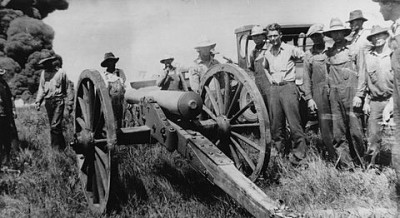
As the petroleum industry expanded westward, frequent lightening strikes in the Great Plains caused oil tank fires. Photo courtesy Kansas Oil Museum. El Dorado, Kansas.
The MIT article not only reported on the fiery results of a lightning strike, but also the practice of using Civil War cannons to fight such conflagrations. Shooting a cannon ball into the base of a burning tank allowed oil to drain safely into a holding pit until the fire died out. “Small cannons throwing a three-inch solid shot are kept at various stations throughout the region for this purpose,” the article noted.
Learn more in Oilfield Artillery fights Fires.

December 17, 1903 – Natural Gas contributes to Aviation History
A handmade engine burning 50-octane gasoline for boat engines powered Wilbur and Orville Wright’s historic 59-second flight into aviation history at Kitty Hawk, North Carolina. The brothers’ “mechanician,” Charlie Taylor, fabricated the 150-pound, 13-horsepower engine in their Dayton, Ohio, workshop.
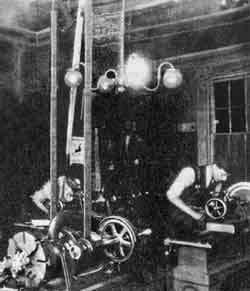
Powered by natural gas, a three-horsepower engine drove belts in the Wright workshop.
The workshop included a single cylinder, three-horsepower natural gas-powered engine that drove an overhead shaft and belts that turned a lathe, drill press — and an early, rudimentary wind tunnel. Natural gas was piped from a field in Mercer County, about 50 miles northwest.
Learn about advances in high-octane aviation fuel in Flight of the Woolaroc.
December 17, 1910 – Petrolia Oilfield discovered in North Texas
Although traces of oil had been found as early as 1904 in Clay county, Texas, a 1910 gusher revealed an oilfield soon named after one of America’s earliest petroleum boomtowns, Petrolia, Pennsylvania. The well southeast of Wichita Falls produced 700 barrels of oil a day from a depth of 1,600 feet.
Annual oil production peaked in 1914 as discoveries at Electra and Burkburnett overshadowed the Petrolia field (see Pump Jack Capital of Texas), according to David Minor of the Texas State Historical Association (TSHA). “Drilling continued, however, as the field turned out to hold the largest known reserve of natural gas in the state,” Minor explained, adding that gas pumped to nearby towns contained .1 percent helium.
“In 1915 the United States Army built the first helium extraction plant in the country at Petrolia, and for several years the field was the sole source of helium for the country,” Minor reported in the TSHA article “Petrolia Oilfield.”
Learn more about helium’s association with natural gas in Kansas “WInd Gas” Well.

_______________________
Recommended Reading: Apollo and America’s Moon Landing Program: Apollo 17 Technical Crew Debriefing (2017); Electric and Hybrid Cars: A History
(2017); Electric and Hybrid Cars: A History (2010); Texas Oil and Gas, Postcard History
(2010); Texas Oil and Gas, Postcard History (2013); Fire on the Horizon: The Untold Story of the Gulf Oil Disaster (2011); The Wright Brothers
(2013); Fire on the Horizon: The Untold Story of the Gulf Oil Disaster (2011); The Wright Brothers (2016); Winners’ Viewpoints: The Great 1927 Trans-Pacific Dole Race
(2016); Winners’ Viewpoints: The Great 1927 Trans-Pacific Dole Race (2009); Helium: Its Creation, Discovery, History, Production, Properties and Uses (2022).
(2009); Helium: Its Creation, Discovery, History, Production, Properties and Uses (2022).
Top history books of 2023 — Your Amazon purchase benefits the American Oil & Gas Historical Society. As an Amazon Associate, AOGHS earns a commission from qualifying purchases.
_______________________
The American Oil & Gas Historical Society (AOGHS) preserves U.S. petroleum history. Become an AOGHS annual supporting member and help maintain this energy education website and expand historical research. For more information, contact bawells@aoghs.org. Copyright © 2023 Bruce A. Wells. All rights reserved.
by Bruce Wells | Nov 20, 2023 | This Week in Petroleum History
November 20, 1866 – Improved Well Torpedo patented –
Col. Edward A.L. Roberts of New York City patented improvements to his Roberts Torpedo, an oilfield technology for increasing production by fracturing oil-bearing formations.
“Our attention has been called to a series of experiments that have been made in the wells of various localities by Col. Roberts, with his newly patented torpedo,” noted the Titusville Morning Herald newspaper in 1865. “The results have in many cases been astonishing.”

Portrait of Edward Roberts, a Civil War veteran who patented well “torpedo” technologies that improved oilfield production.
The Civil War Union Army veteran would receive many patents for his “Exploding Torpedoes in Artesian Wells” method to increase petroleum production (see Shooters – A “Fracking” History).
November 20, 1930 – Oil Booms help Hilton expand in Texas
After buying his first hotel in the booming oil town of Cisco, Texas, Conrad Hilton opened a high-rise in El Paso. While visiting Cisco in 1919, Hilton had witnessed roughnecks from the Ranger oilfield waiting for rooms. Hilton’s first hotel, the Mobley, offered 40 rooms for eight-hour periods to coincide with workers’ shifts.
Thanks to booming oilfields, Hilton was firmly established in the Texas hotel business. His El Paso Hilton (now the Plaza Hotel) was placed on the National Register of Historic Places in 1980.

November 20, 1980 – Texaco Well drains Louisiana Lake
Minutes after its drilling crew evacuated, a Texaco drilling platform overturned and disappeared into a whirlpool that drained Lake Peigneur, Louisiana, over the next three hours. The crew had accidently penetrated a salt dome containing the mining operations of Diamond Crystal Salt Company.
All 50 miners working as deep as 1,500 feet below the surface escaped with no serious injuries as a maelstrom swallowed the $5 million Texaco platform — and 11 barges holding drilling supplies.
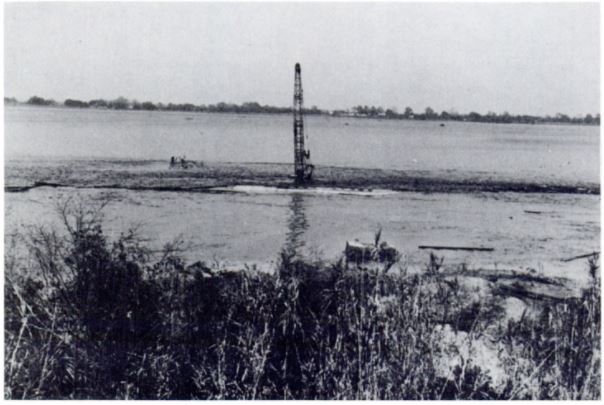
Photo from a 1981 government report on Texaco’s accidental “Jefferson Island Mine Inundation” of one year earlier.
“Texaco, who had ordered the oil probe, was aware of the salt mine’s presence and had planned accordingly; but somewhere a miscalculation had been made, which placed the drill site directly above one of the salt mine’s 80-foot-high, 50-foot-wide upper shafts,” noted a 2005 article.
According to a 1981 government report, “Jefferson Island Mine Inundation,“ evidence for identifying the exact cause was washed away, but Texaco and Wilson Drilling paid $32 million to Diamond Crystal Salt Company and another $12.8 million to a nearby botanical garden. Changed from freshwater to saltwater with a depth reaching 200 feet, Lake Peigneur became the deepest lake in Louisiana.
November 21, 1925 – Magnolia Petroleum incorporates –
Formerly an unincorporated joint-stock association with roots dating to an 1889 refinery in Corsicana, Texas, Magnolia Petroleum Company incorporated. The original association had sold many grades of refined petroleum products through more than 500 service stations in Texas, Oklahoma, and Arkansas.
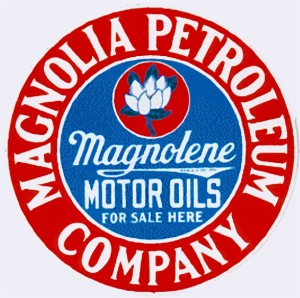
Magnolia Petroleum operated gas stations throughout the Southeast.
Within a month of the new company’s founding, John D. Rockefeller’s Standard Oil of New York (Socony) purchased most Magnolia Petroleum assets and operated it as a subsidiary. Magnolia merged with the Socony Mobile Oil Company in 1959 and adopted the red Pegasus logo, replacing the magnolia logo at gas stations (see Mobil’s High-Flying Trademark). Magnolia Petroleum assets were part of 1999 merger that created today’s ExxonMobil.

November 21, 1980 – Millions watch “Dallas” Episode Who shot J.R
The cliffhanger episode “Who shot J.R.?” on the prime-time soap opera “Dallas” was watched by 83 million people in the United States and 350 million worldwide, according to History.com. The CBS show, which debuted in 1978, revolved around two Texas oil families and featured Larry Hagman as J.R. Ewing, “the character fans loved to hate.” His portrayal of a “greedy, conniving, womanizing scoundrel” and the business dealings of Ewing Oil Company would stereotype the Texas petroleum industry for 14 seasons.
November 22, 1878 – Tidewater Pipe Company established
Byron Benson organized the Tidewater Pipe Company in Pennsylvania. In 1879 his company would build the first oil pipeline to cross the Alleghenies from Coryville to the Philadelphia Reading Railroad 109 miles away in Williamsport. This technological achievement was considered by many as the first true oil pipeline in America, if not the world.
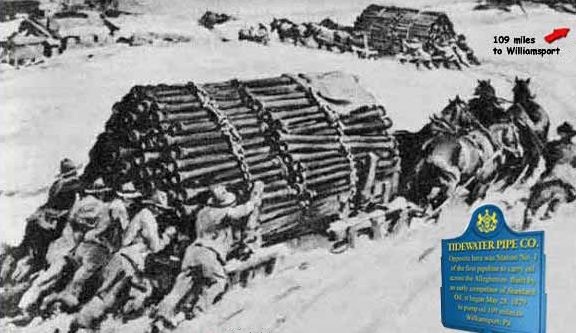
Despite protests from teamsters, a 109-mile oil pipeline revolutionized oil transportation. Photo courtesy explorepahistory.com.
The difficult work — much of it done in winter using sleds to move pipe sections — bypassed Standard Oil Company’s dominance in transporting petroleum. Tidewater made an arrangement with Reading Railroad to haul the oil in tank cars to Philadelphia and New York. In 1879, about 250 barrels of oil from the Bradford field was pumped across the mountains and into Williamsport.
More than 80 percent of America’s oil soon would come from Pennsylvania oilfields, according to Floyd Hartman Jr. in a 2009 article, “Birth of Coryville’s Tidewater Pipe Line.”

November 22, 1905 – Glenn Pool Field discovered in Indian Territory
Two years before Oklahoma statehood, the Glenn Pool (or Glenpool) oilfield was discovered in the Creek Indian Reservation south of Tulsa. The greatest oilfield in America at the time, it would help make Tulsa the “Oil Capital of the World.” Many independent oil producers, including Harry Sinclair and J. Paul Getty, got their start during the Glenn Pool boom.
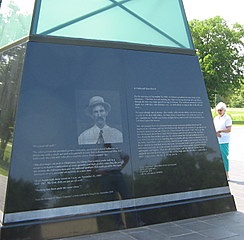
An oilfield pioneers monument was dedicated in April 2008 at Glenpool, Oklahoma. Photo by Bruce Wells.
With production exceeding 120,000 barrels of oil a day, Glenn Pool exceeded Tulsa County’s earlier Red Fork Gusher. The giant oilfield even exceeded production from Spindletop Hill in Texas four years earlier. The Ida Glenn No. 1 well, drilled to about 1,500 feet deep, led to more prolific wells in the 12-square-mile Glenn Pool.
By the time of statehood in 1907, Tulsa area oilfields made Oklahoma the biggest U.S. oil producing state. Advances in enhanced recovery technologies later added to the region’s productivity. Glenpool residents celebrate their “Black Gold Days,” and the 46th annual festival took place September 26-29, 2023, in Black Gold Park.
Learn more in Making Tulsa “Oil Capital of the World.”
November 22, 2003 – Smithsonian Museum opens Transportation Hall
A permanent exhibit about U.S. transportation history opened at the Smithsonian’s National Museum of American History in Washington, D.C. “Get your kicks on 40 feet of Route 66,” the Smithsonian exhibit noted on opening day of the $22 million renovation of the museum’s Hall of Transportation.
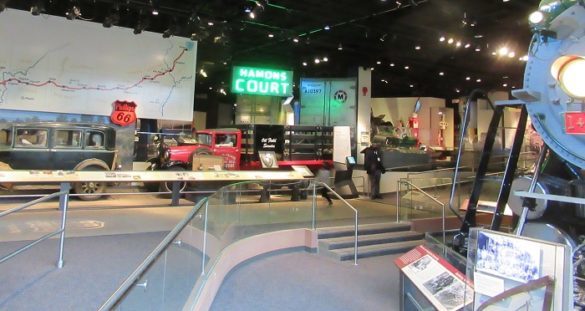
Opened in 2003 after a $22 million renovation, the Transportation Hall of the National Museum of American History exhibits 340 historic objects in 26,000 square feet. Photo by Bruce Wells.
The hall was designed to let visitors “travel back in time and experience transportation as it changed America.” Opening day exhibits included 340 objects and 19 historic settings in chronological order. At the same museum in 1967, the Smithsonian’s “Hall of Petroleum” devoted an entire wing to drilling rigs, pipelines, and pump jacks.
Learn more in America on the Move.
November 23, 1951 – Superman and the World’s Deepest Oil Well
Public fear of the risk of drilling wells too deep highlighted the theatrical release of Superman’s first feature length movie, “Superman and the Mole Men.” The 1951 plot unfolded in the fictional town of Silsbey, “Home of the World’s Deepest Oil Well,” after an experimental well’s drill bit had “broken into clear air” at a depth of 32,742 feet.
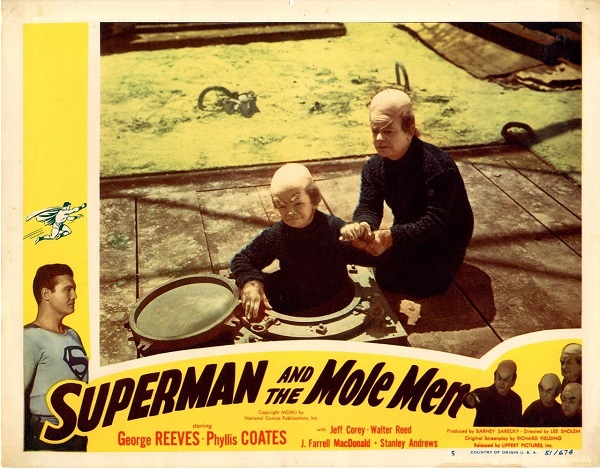
Mole men emerge from an experimental oil well drilled more than six miles deep.
“Good heavens, that’s practically to the center of the earth!” exclaimed Lois Lane (in fact, the deepest U.S. well in 1951 reached 20,521 feet). When mole-men emerged from the well, townspeople feared an invasion. In the end, Superman calmed an angry mob and the well ignited in flames, forever closing the connection between the two worlds.
Learn about a real six-mile-deep well in Anadarko Basin in Depth.

November 23, 1947 – World’s First LPG Ship
The first U.S. seagoing Liquefied Petroleum Gas (LPG) ship went into service as Warren Petroleum Corporation of Tulsa, Oklahoma, sent the Natalie O. Warren from the Houston Ship Channel to Newark, New Jersey. The vessel had an LPG capacity of 38,053 barrels in 68 vertical pressure tanks.

The first vessel had an LPG capacity of 38,053 barrels in 68 vertical pressure tanks.
The one-of-a-kind ship was the former Cape Diamond dry-cargo freighter, converted by the Bethlehem Steelyard in Beaumont, Texas. The experimental design would lead to new maritime construction standards for such vessels. Warren Petroleum was the largest producer and marketer of natural gasoline and propane in the world by the early 1950s, according to an exhibit at the Tulsa Historical Society and Museum. LPG tankers today carry 20 times the capacity of the early vessels.
November 25, 1875 – Continental Oil brings Kerosene to the West
Convinced that he could profit by purchasing bulk kerosene in cheaper eastern markets, Isaac Blake formed the Continental Oil and Transportation Company. He soon transported Ohio kerosene to Ogden, Utah, for distribution.
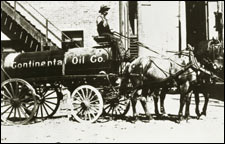
Conoco began in 1875 as Continental Oil, delivering kerosene to retail stores in Ogden, Utah.
Continental purchased two railroad tank cars — the first to be used west of the Mississippi River — and began shipping kerosene from a Cleveland refinery. The company grew, expanding into Colorado in 1876 and California in 1877. Standard Oil Company absorbed Continental Oil in 1885.
Following the 1911 breakup of Standard, Continental Oil reemerged as Conoco, becoming ConocoPhillips in 2002 (see ConocoPhillips Petroleum Museums).
_______________________
Recommended Reading: History Of Oil Well Drilling (2007); Be My Guest
(2007); Be My Guest (1957); Magnolia Oil News Magazine
(1957); Magnolia Oil News Magazine (January 1930); Oil and Gas Pipeline Fundamentals
(January 1930); Oil and Gas Pipeline Fundamentals (1993); Glenn Pool…and a little oil town of yesteryear
(1993); Glenn Pool…and a little oil town of yesteryear (1978); The American Highway: The History and Culture of Roads in the United States
(1978); The American Highway: The History and Culture of Roads in the United States (2000); CONOCO: The First One Hundred Years Building on the Past for the Future
(2000); CONOCO: The First One Hundred Years Building on the Past for the Future (1975). Your Amazon purchase benefits the American Oil & Gas Historical Society. As an Amazon Associate, AOGHS earns a commission from qualifying purchases.
(1975). Your Amazon purchase benefits the American Oil & Gas Historical Society. As an Amazon Associate, AOGHS earns a commission from qualifying purchases.
_______________________
he American Oil & Gas Historical Society (AOGHS) preserves U.S. petroleum history. Become an AOGHS annual supporting member and help maintain this energy education website and expand historical research. For more information, contact bawells@aoghs.org. Copyright © 2023 Bruce A. Wells. All rights reserved.








